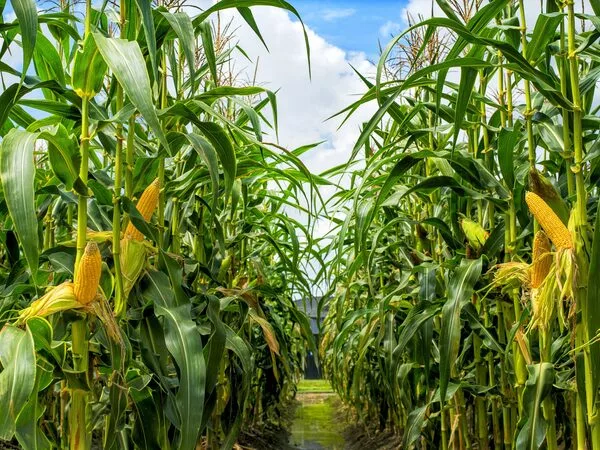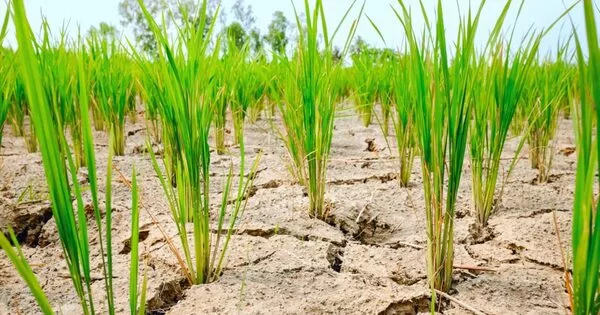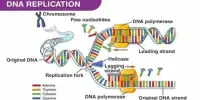What happens belowground in a cornfield is easy to overlook, but corn root architecture can play an important role in water and nutrient acquisition, affecting drought tolerance, water use efficiency, and sustainability. If breeders could encourage corn roots to grow down at a steeper angle, the crop could potentially access important resources deeper in the soil.
A first step toward that goal is identifying the genes involved in gravitropism, or root growth in response to gravity. In a new study published in the Proceedings of the National Academy of Sciences, University of Wisconsin scientists collaborated with researchers from the University of Illinois to identify four such genes in corn and the model plant Arabidopsis.
When a germinating seed is turned on its side, some roots turn abruptly and steeply towards gravity, while others turn more slowly. The researchers observed subtle differences in root gravitropism in thousands of seedlings using machine vision methods and combined that data with genetic information for each seedling. The findings helped to map the likely locations of gravitropism genes in the genome.
The map guided the researchers to the correct neighborhood in the genome regions of several hundred genes, but they were still a long way from identifying specific genes for gravitropism. They were fortunate to have a tool that could assist them.
The root gravitropism phenotype was measured in a highly controlled manner. These seeds were grown on a petri plate, and the experiment lasted only hours, as opposed to traits measured in the real world, which are subject to a wide range of variations.
Edgar Spalding
“Because we had previously performed the same experiment with the distantly related Arabidopsis plant, we were able to match genes within the relevant regions of the genome in both species. Follow-up tests verified the identity of four genes that modify root gravitropism. The new information could help us understand how gravity shapes root system architectures,” says Edgar Spalding, professor in the Department of Botany at the University of Wisconsin and lead author of the study.
Matt Hudson, professor in the Department of Crop Sciences at the University of Illinois and study co-author, adds, “We looked at an under-researched trait in maize that is important for a number of reasons, especially in the context of climate change. And we did it by making the evolutionary differences between plants work in our favor.”
Corn and Arabidopsis, a small mustard relative exhaustively described by plant biologists, evolved about 150 million years apart in evolutionary history. Hudson explains that although both species share basic plant functions, the genes controlling them have likely been jumbled within the genome over time. That’s turns out to be a good thing for narrowing down common genes.

Genes in closely related species tend to line up in roughly the same order in the genome (e.g., ABCDEF). Despite the fact that the same genes may exist in distantly related species, the order of genes in the region where the trait maps does not match (e.g., UGRBZ). After the researchers determined where to look in each genome, the otherwise mismatched gene sequences highlighted the common genes (in this case, B).
“I thought it was really cool that we were able to find genes that we wouldn’t have found otherwise simply by comparing genomic intervals in unrelated plant species,” Hudson says. “We were pretty sure they were the right genes when they popped right out of this analysis, but Spalding’s group then spent another seven or eight years collecting solid biological data to confirm they do, in fact, play a role in gravitropism. After that, I believe we’ve validated the entire approach to the point where you could use it for a variety of phenotypes in the future.”
Spalding notes the method was probably particularly successful because precise measurements were made in a common environment.
“Maize researchers frequently measure their traits of interest in the field, whereas Arabidopsis researchers raise their plants in growth chambers,” he explains. “The root gravitropism phenotype was measured in a highly controlled manner. These seeds were grown on a petri plate, and the experiment lasted only hours, as opposed to traits measured in the real world, which are subject to a wide range of variations.”
Even when traits can be measured in the same environment, not all traits are suitable for this method. The researchers emphasize that the traits under consideration should be fundamental to basic plant function, ensuring that the same ancient genes exist in unrelated species.
“Gravitropism may be especially amenable to study using this approach because it would have been critical to the original specialization of shoots and roots following successful land colonization,” Spalding says.
Hudson believes gravitropism will also be important in the colonization of a new landscape. “NASA is interested in growing crops on other planets or in space, and they need to know what you’d have to breed for that,” he says. “Plants are pretty disoriented without gravity.”
















